Not all cancer insurances cover carcinoma in situ (CIS) so it’s important to review the terms and conditions before buying.
Bowtie’s product development team is here to explain more on cancer insurance, including different types, waiting period, claim methods, premiums and things to note when comparing plans.
Q1: What are the differences between Cancer Medical Insurance and Cancer Critical Illness Insurance?
Bowtie’s Product Development: There is no standardized definition for cancer insurance in Hong Kong. Currently, there are 2 kinds of cancer insurances in the market: Cancer Medical Insurance and Cancer Critical Illness Insurance.
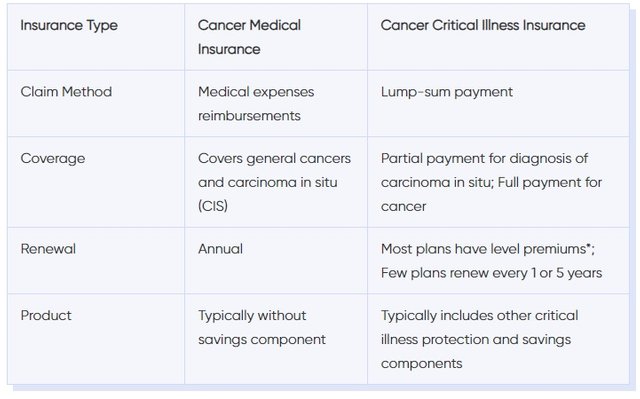
In a nutshell, “Cancer Medical Insurance” pays for the medical expenses while “Cancer Critical Illness Insurance” pays for medical expenses and supports the insured’s living expenses.
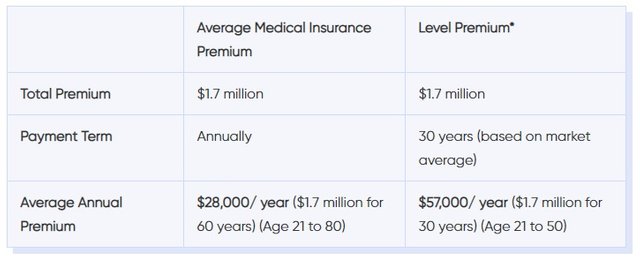
The above table compares the policyholder’s contribution for Cancer Medical Insurance and Cancer Critical Illness Insurance (with level premium). As you can see, due to different payment terms, the level premium for Cancer Critical Illness Insurance is 2 times more than the Cancer Medical Insurance, assuming the total premiums for both plans are $1.7 million and the policyholder has a lifespan of 80 years and has been insured since age 21.
Most critical illness insurance plans have savings components and offer policyholders a portion of the premiums back if the policy is terminated. However, the premiums for this type of insurance are also higher.
Insurance Tip: Level premium means the premiums would stay the same throughout the payment term. General medical insurance’s premiums often increase accordingly to age when it is renewed annually.
Q2. Is coverage for Carcinoma in sit (CIS) important?
Bowtie’s Product Development: Carcinoma in situ (CIS) is a group of abnormal cells that may become cancer and have not spread beyond where they are found. CIS is sometimes referred to as “Stage 0 cancer”. If CIS is not properly treated in time, it can spread to surrounding tissues and organs and become an aggressive cancer.
Common carcinoma in situ include breast, bladder, cervical CIS and so on. Many cancer critical illness insurance plans in the market offer no protect against CIS, or offer only a small portion of the sum assured. But it’s worth mentioning that the surgery fees for CIS are comparable to surgery fees for cancer. Hence, coverage for CIS is an important consideration.
Since “Cancer Critical Illness Insurance” is similar to general critical illness insurance, we will focus on “Cancer Medical Insurance” in the article.
Q3. What are the key differences between Cancer Medical Insurance, General Medical Insurance and VHIS?
Product Development: The following table highlights the key differences between “Cancer Medical Insurance”, “General Medical Insurance” and “VHIS”.
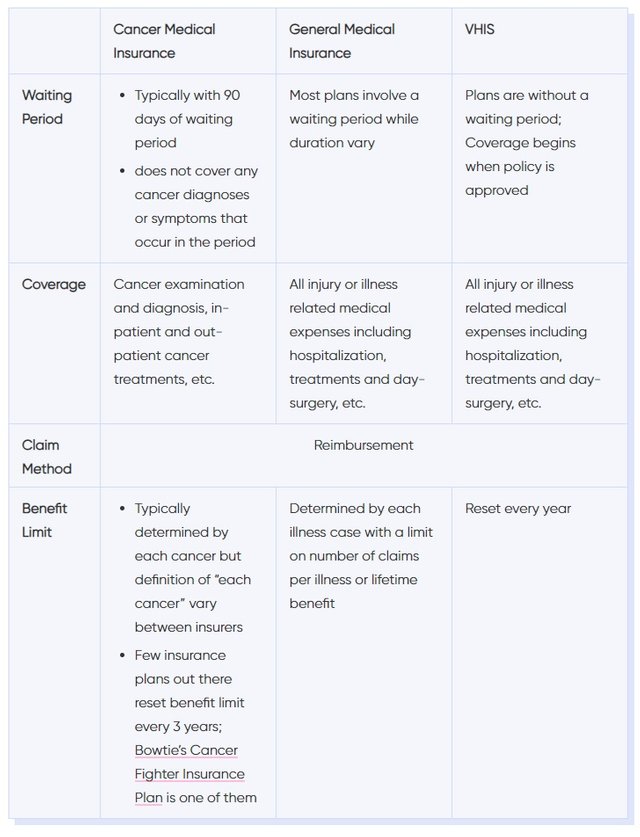
Q4. Are all cancer treatments covered in cancer insurance?
Bowtie’s Product Development: Since cancer insurance focuses on cancer, its coverage is very comprehensive, which includes coverage on diagnosis, treatment and rehabilitation.
- Cancer Diagnostic Tests (with objective to diagnose cancer)
- Exclude general body check or preventive genetic tests because the purpose of these examinations is not to diagnose cancer
- Exclude tests with negative results because the insured does not have cancer
- Tests for determining which drugs should be used for treatment (i.e. some drugs are suitable to treat cancers with specific gene mutations only)
- Tests for monitoring the progress of treatment or rehabilitation
- Cancer Treatments
- Surgery
- Chemotherapy
- Electrotherapy
- Targeted therapy
- Immunotherapy
- Proton therapy
- Other treatments (including new treatment methods from medical breakthrough or advanced medical technology)
- Palliative Treatments (to provide relief from cancer symptoms)
- Head and/or Breast Reconstructive surgery
- Complementary Treatments (Chinese medicine, Physiotherapy, Counselling, etc.)
In addition to the above, some cancer insurance plans also cover transportation expenses, wigs, global emergency support and other related expenses. However, more coverage also comes with higher premiums.
Q5. How pricey are cancer treatments?
Bowtie’s Product Development: According to data from the Hong Kong Cancer Information Center of the Hospital Authority, colon, lung, breast and liver cancer are the most common cancers in Hong Kong. The medical treatment fees for these cancers are listed below for reference.
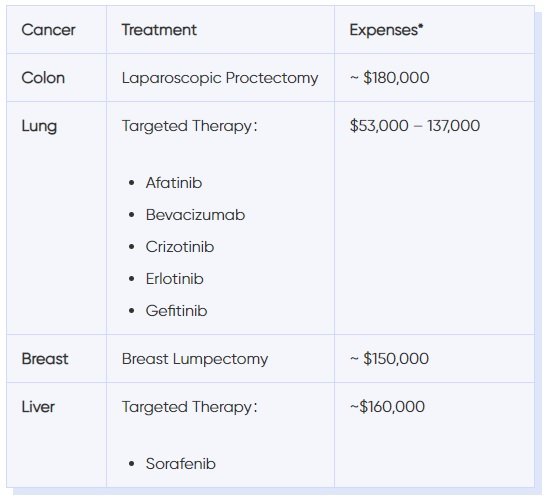
Definitions of cancer recurrence vary between insurance companies
*Above price updated as of January 23, 2020
Q6. How much compensation on cancer insurance is enough?
Bowtie’s Product Development: Cancer insurance plans in the market generally offer compensation between $500,000 to $3 million for each cancer while lifetime limit is 3 times the amount of each compensation. However, insurance companies define “each cancer” differently and very few plans reset benefit every 3 years. Since cancer can often recur but timing is unpredictable, it is important to understand the compensation terms and conditions before purchasing a plan.
Bowtie Cancer Fighter offers $1 million, $2 million and $3 million lifetime benefit options for the entire journey from cancer diagnosis to treatment monitoring (effective until 5 years after the final treatment), recurrence and diagnosis of other cancers.
In the unfortunate event of cancer diagnosis, $1 million benefit for cancer treatment is immediately activated, which is sufficient to cover the treatment cost for most cancers within 3 years. As for the policyholders of “Cancer Fighter 200” & “Cancer Fighter 300”, the abovementioned $1 million benefit would be reset every 3 years once activated for further protection on cancer recurrence and diagnosis of other cancers until the amount of compensation reaches the lifetime limit.
Q7. Is Bowtie’s Cancer Fight most competitive among all?
The table below compares the premiums of cancer medical insurance plans from the three largest insurance companies in Hong Kong for reference.
Non-smoking Male
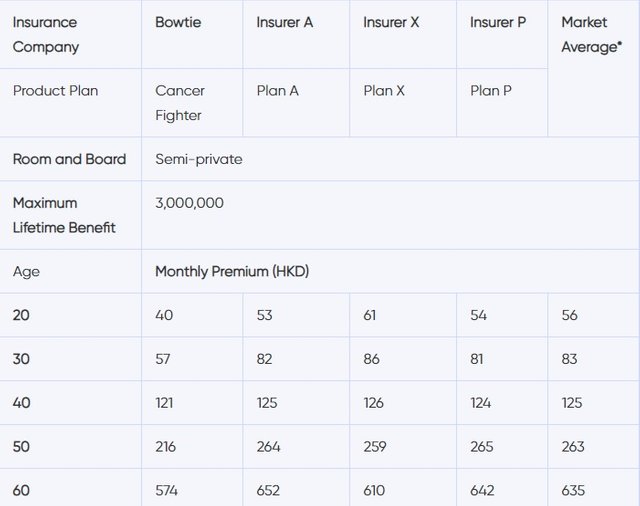
*Premiums are rounded to the nearest whole integer. Premium information was updated as of January 2020.
Please note the coverage of the cancer medical insurance plans vary. For coverage and plans details, please refer to the information provided by the insurance companies. If you have any inquiries about the above comparisons, please contact Bowtie customer service specialists.
Non-smoking Female
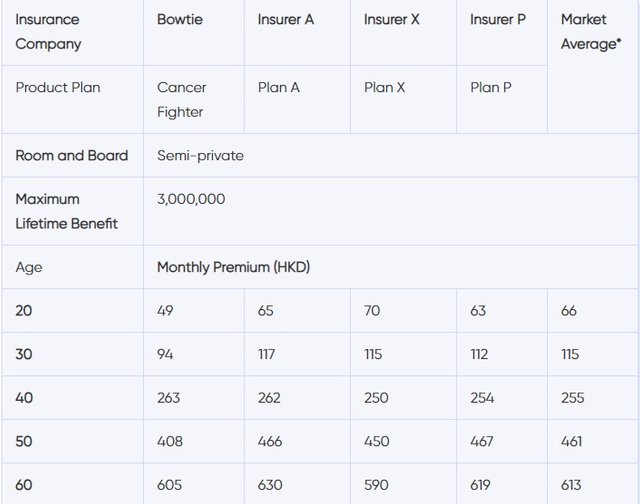
Q8. Why are women's premiums higher?
Product Development: Based on the above tables, premiums for females are generally higher than for men because the risk of developing cancer for women between ages 20 to 59 is much higher than men in the same age groups. Breast and cervical cancers are among the most common cancers in women of the age group.
Original Article: Cancer Insurance Comparison: Coverage & Waiting Period (https://www.bowtie.com.hk/blog/en/cancer-insurance-comparison-coverage-waiting-period/)
Learn more about Bowtie's products.
- Cancer Fighter: https://www.bowtie.com.hk/en/insurance/cancer
- Bowtie VHIS Flexi Plan: https://www.bowtie.com.hk/en/insurance/vhis/flexi